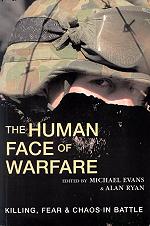The Human Face of Warfare is a collection of eleven essays on the human face of warfare from a number of perspectives involving interdisciplinary. The essays were presented at the Australian Army’s inaugural international conference during March 1999. The theme of the conference was that a modern army’s most precious asset remains the quality of its soldiers.
The introduction notes that no one approach by academics has attained sufficient breadth to fuse together different branches of knowledge to create a comprehensive theory of war at the human level. The essays address a number of factors from the psychology and physiology of close combat to realistically reproducing chaos. It would, in my view, spoil it for the reader if in this book review comments were made on each of the individual chapters, as such, I have limited my comments to chapters two and four, together with a brief footnote on the “engines of war” written by Donn Draeger, which is worthy of consideration.
The essay by Colonel Stephen Tetlow, British Army, in chapter two, on incorporating human factors in simulation and modelling, was particularly interesting with a good overview of how the UK Ministry of Defence addresses the issue. The conclusion reflects the content of the essay, and provides a good summary on conflict and the challenges ahead for future operations “…our prevailing view of the future battlespace – that is, that conflict is, and will remain, essentially a human activity, in which the human qualities of judgement self-discipline and courage, the moral component of fighting power, will endure. To out-think, break, and if necessary kill an opponent, while retaining the moral high-ground, will be fundamental, if not essential, to the success of future operations.”
Chapter four written by Associate Professor Hugh Smith dealt with “Public perceptions of bearable cost in a democracy” and discusses public expectations of war and the individuals targeted to join the military now and in the future. The essay notes that while individual pacifists and scepticism about war have existed as long as armies, it has only been since the 1880s that the first broad-based opposition to war as a social institution appear. The essay covers the current trend of increased opposition to war and the greater concern for personal security, together with an increase in casualty aversion, which in turn is leading to demands for a safer military. The writer of the essay also notes that precision-guided missiles, together with the other trends mentioned above, may radically change war itself. Even though this article was written six years ago it is still relevant to the environment and considerations in which military operations are conducted today.
Overall the book gives some great insights into various areas associated with humans in warfare. The common thread in the essays was the need to study the various relationships of combat-training performance to battlefield performance warfare to enable humans to succeed in conflict. After reading the book I have no hesitation in recommending it to anyone who is interested in Hoplology study. All the essays, written by leaders in their field, were informative and interesting. The editors Dr Michael Evans and Dr Alan Ryan, both Senior Research Fellows in the Land Warfare Studies Centre, Duntroon, Canberra, Australia have combined well to publish material on the human dimensions of modern conflict.
The conclusion drawn by the author is worthy of further consideration “Future adversaries will take their military activities to the jungles and the cities where information technology is less efficient and troops on the ground are formidable opponents. To counter such forces….will require…’greater rallying’ of human and moral forces, as relying on machines and computers will not be enough”.
Footnote: It was interesting to read the article by Donn F. Draeger titled “Hoplology and the Bang, Big or Small” in HOPLOS Volume 1, Number 6, published in November 1979. In the article the Donn Drager reminds Hoplologists not to consign the study of “engines of war” [artillery, air-craft, rockets, firemans, armoured combat boats and ships, guided missiles and fortified positions] to a lower priority. Since 1979 there have been additional new factors and challenges ahead for Hoplologists which are touched on in the publication of “The Human Face of Warfare”, these include, but are not limited to, the role of the media, high-level operations using cellular automata, computers and digitisation to name but a few.
